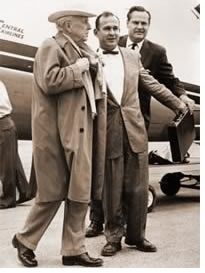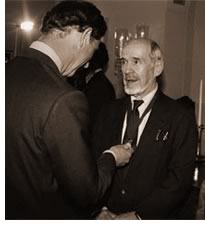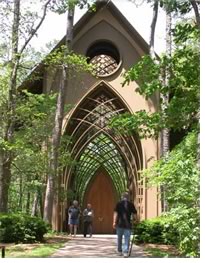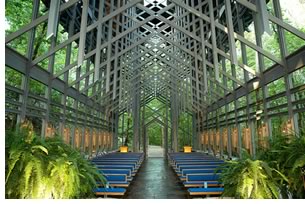

09/2004
 by
Norman L. Koonce, FAIA
by
Norman L. Koonce, FAIA
AIA Executive Vice President/CEO
On August 30, 2004, a gentle man of consummate genius left us: E. Fay Jones, FAIA, died from upper respiratory complications and heart failure at his home in Fayetteville, Arkansas. He was 83 years old.
The facts of his life are these: Jones received a bachelor’s degree in architecture from the University of Arkansas in 1950 and his master’s in architecture from Rice University in 1951. In 1953, he received a Taliesin Fellowship, which enabled him to study with architect Frank Lloyd Wright. Jones later received an honorary doctorate from the University of Arkansas in 1990. Along the way, he met and married his helpmeet for life, Gus. Together the two were a living contradiction to the false notion that humility and genius cannot exist in the same place at the same time.
 Jones
had a long and distinguished professional career that combined teaching
and practice. He taught at the University of Oklahoma and had a long tenure
at the University of Arkansas as a design professor, chairperson of the
department from 1966–1974, and as dean from 1974–1976.
Jones
had a long and distinguished professional career that combined teaching
and practice. He taught at the University of Oklahoma and had a long tenure
at the University of Arkansas as a design professor, chairperson of the
department from 1966–1974, and as dean from 1974–1976.
In 1990, Jones received from President George H.W. Bush American architecture’s highest honor for individual achievement, the American Institute of Architects’ Gold Medal, in a special White House ceremony. Later that same day, at the AIA/AAF Accent on Architecture Gala, in Washington, Jones was similarly honored by HRH Charles, Prince of Wales.
 At
that year’s AIA convention, he recounted his reverie for his mentor
Frank Lloyd Wright—telling of hitchhiking to the 1949 convention
to see Wright receive his Gold Medal. Later, people noted that what became
known as Jones’ Ozark Style was reminiscent of Wright’s Prairie
Style and began calling him “the small Frank Lloyd Wright,”
he recalled. On hearing of this, Wright retorted, “There is no such
thing as a small Frank Lloyd Wright.”
At
that year’s AIA convention, he recounted his reverie for his mentor
Frank Lloyd Wright—telling of hitchhiking to the 1949 convention
to see Wright receive his Gold Medal. Later, people noted that what became
known as Jones’ Ozark Style was reminiscent of Wright’s Prairie
Style and began calling him “the small Frank Lloyd Wright,”
he recalled. On hearing of this, Wright retorted, “There is no such
thing as a small Frank Lloyd Wright.”
In a 1991 poll, AIA members ranked Jones among the 10 most influential architects of the time, a list that also included I.M. Pei, Robert Venturi, Charles Moore, and Michael Graves. In 2000, Jones’ Thorncrown Chapel in Eureka Springs, Ark., was voted the fourth best building of the 20th century, after Fallingwater and New York’s Chrysler and Seagram’s buildings. Robert Ivy, FAIA, architecture scholar, critic, and Jones biographer, described Thorncrown as “arguably among the 20th century’s great works of art.”
 In
his autobiography, former President Bill Clinton wrote fondly of a Fay
Jones-designed house he lived in while teaching at the University of Arkansas:
“I found the perfect place to live, a beautiful little house . .
. [It] proved to be a godsend of peace and quiet, especially after I started
my first campaign.”
In
his autobiography, former President Bill Clinton wrote fondly of a Fay
Jones-designed house he lived in while teaching at the University of Arkansas:
“I found the perfect place to live, a beautiful little house . .
. [It] proved to be a godsend of peace and quiet, especially after I started
my first campaign.”
Upon learning of Jones’ passing, AIA President Eugene C. Hopkins, FAIA, said: “This is a huge loss for the profession. He was an inspirational designer, an icon in the profession. He had a very special ability for creating space in perfect harmony with nature. The loss of his personal presence leaves a large void that can only be filled by the incredible legacy of the architecture he has so graciously bestowed upon us.”
 Fay
Jones’ achievements are elemental. However, elemental should not
be confused with naïve or even “organic.” Quite apart
from the extraordinary craftsmanship and the imagination of his designs,
he asserted with breathtaking simplicity the destiny and true power of
architects, which is to be a respectful mediator between the world of
man and nature. What is both remarkable and telling is that Jones showed
at Thorncrown Chapel and in his other works that this power can be wielded
not to dominate, but to advance an ennobling vision of our race.
Fay
Jones’ achievements are elemental. However, elemental should not
be confused with naïve or even “organic.” Quite apart
from the extraordinary craftsmanship and the imagination of his designs,
he asserted with breathtaking simplicity the destiny and true power of
architects, which is to be a respectful mediator between the world of
man and nature. What is both remarkable and telling is that Jones showed
at Thorncrown Chapel and in his other works that this power can be wielded
not to dominate, but to advance an ennobling vision of our race.
In a keynote presentation by Dr. Robert H. Schuller, Hon. AIA, at the 1989 AIA National Convention, I recall him saying that the four necessary and distinguishing traits for being or becoming a great architect are honesty, humility, hospitality, and humanity. Those terms describe so well the character, integrity, and the person of E. Fay Jones, FAIA. We will miss him greatly.
Copyright 2004 The American Institute of Architects.
All rights reserved. Home Page ![]()
![]()
